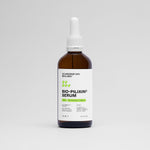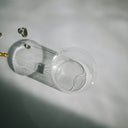Finasteride is a medication that has been widely used to treat conditions such as male pattern baldness and benign prostatic hyperplasia (BPH). As more people become aware of the role of hormones in various health issues, questions regarding the mechanisms of action of medications like finasteride have surged. One common inquiry is whether finasteride acts as a DHT blocker.
Table of content
Is finasteride a DHT blocker?
Yes, finasteride is a DHT (dihydrotestosterone) blocker. It works by inhibiting the enzyme 5-alpha reductase, which is responsible for converting testosterone into DHT. By blocking this conversion, finasteride effectively lowers the levels of DHT in the body. This is particularly significant because DHT is a key hormone linked to hair loss in men and is also implicated in the enlargement of the prostate gland. By reducing DHT levels, finasteride can help prevent hair loss and improve symptoms associated with prostate enlargement.
Understanding the role of DHT in the body is essential for grasping why finasteride is prescribed. DHT is a potent androgen, which means it influences the development and maintenance of male characteristics. While it plays a crucial role during puberty and in maintaining male sexual health, elevated DHT levels can lead to hair thinning and prostate issues in adulthood.
As your leading source for hair health information over the past 4 years, we never compromise on accuracy. When it comes to your health, you deserve information you can truly rely on - and earning your trust is our top priority.
Here's how Scandinavian Biolabs ensures every piece of content meets the highest standards of accuracy and integrity:
- Credentialed Experts: Our reviewers are actively practicing doctors and medical researchers
- Stringent Reviews: Content undergoes rigorous editing by subject specialists and review by a practicing doctor.
- Evidence-Based: We rely on well-established research from trusted scientific sources like peer-reviewed journals and health authorities.
- Full Transparency: Our editorial standards, writer credentials, reviewer credentials, correction process, and funding are all publicly documented.
- Independent Voice: While we do promote products, we operate in a vacuum to business operations. Our main goal is just an unwavering commitment to providing medically-sound guidance.
You can count on Scandinavian Biolabs to consistently deliver the trustworthy health information you deserve. Read our Editorial Standards.
How does finasteride work as a DHT blocker?
Finasteride specifically targets and inhibits the type II form of the 5-alpha reductase enzyme. This enzyme is predominantly found in hair follicles and the prostate. By blocking this enzyme, finasteride reduces DHT production, which can slow down or even reverse hair loss in men suffering from androgenetic alopecia (male pattern baldness). In the context of BPH, lowering DHT levels can lead to a reduction in prostate size, alleviating urinary symptoms associated with this condition.
Benefits of using finasteride as a DHT blocker
1. **Hair Loss Prevention**: Finasteride is most commonly used in treating male pattern baldness. Studies have shown that it can effectively promote hair regrowth and prevent further hair loss in many patients. Users often report noticeable improvements within a few months of consistent use.
2. **Prostate Health**: For men with BPH, finasteride can significantly improve urinary flow and reduce the risk of surgical interventions. By decreasing the size of the prostate, patients may experience relief from symptoms such as frequent urination, difficulty starting and stopping urination, and a weak urine stream.
3. **Hormonal Balance**: By reducing DHT levels, finasteride can help restore a more favorable balance of hormones in men, which may contribute to overall hormonal health.
Potential side effects of finasteride
While finasteride is effective for many, it is not without potential side effects. Some users may experience:
- Decreased libido
- Erectile dysfunction
- Reduced semen volume
- Gynecomastia (breast tissue enlargement)
These side effects can be concerning, and it's important for individuals considering finasteride to discuss these risks with their healthcare provider. In most cases, side effects are mild and may resolve after discontinuing the medication.
Who should consider finasteride?
Finasteride is primarily prescribed for adult men dealing with male pattern baldness or BPH. It is important to note that finasteride is not recommended for women, especially those who are pregnant or may become pregnant, due to potential risks to fetal development. If you are a man experiencing hair loss or urinary issues, discussing the pros and cons of finasteride with your doctor can help determine if it is a suitable option for you.
Conclusion
In conclusion, finasteride is indeed a DHT blocker that functions by inhibiting the enzyme 5-alpha reductase, thereby reducing DHT levels in the body. Its ability to help prevent hair loss and improve prostate health makes it a valuable option for many men. However, potential side effects and individual health considerations should always be taken into account. Consulting with a healthcare professional can provide clarity on whether finasteride is the right choice for your specific needs.
Tired of Thinning Hair? Try a Clinically Tested Serum.
Looking for a natural way to regrow hair and achieve a thicker, fuller head of hair? Ditch the stinging nettle for hair loss – Bio-Pilixin Serum is a drug-free hair activation serum that delivers clinically tested results.
Here's why Bio-Pilixin is superior:
- Clinically Tested Results: 93% of users saw a reduction in hair loss, and 73% experienced increased hair density.
- Safe and Natural: Unlike harsh chemicals, Bio-Pilixin uses plant growth factors derived from stem cell technology to nourish hair follicles and stimulate growth.
- Fast-Acting: See visible results in as little as 45 days (most typically see results within 150 days).
Stop wasting time on unproven remedies. Bio-Pilixin is the safe, natural serum you've been searching for.
Read more:






